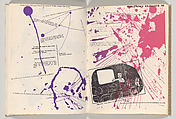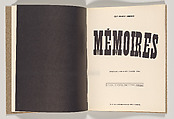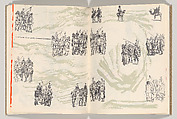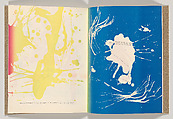Mémoires
Asger Jorn Danish
Guy Debord French
Not on view
Mémoires was the second collaboration between the writer, activist, and founder of the Situationist International Guy Debord and the artist Asger Jorn; in 1957 they had created Fin de Copenhague, an illustrated book that was allegedly made in a twenty-four hour period. Mémories represents a radical rethinking of the illustrated book, as well as genres such as biography, history, and the artist’s book. It tells the intellectual autobiography of Debord, then twenty-six years old, and the creation of the Situationist International. Rather than written passages, the book is constructed through détourned or repurposed found materials, such as newspaper clippings, photographs, cartoons, and advertisements, as well as quotations from figures who included Marx and Huizinga, as well as the popular press. Eschewing a strict vertical and horizontal orientation, the book instead proposes an all-over viewing, as if navigating a map, yet with no direction given. In this way, it evokes the Situationist concept of psychogeography, as well as the dérive, or found object. Jorn, associated with the CoBrA movement (derived from the first letters of the artists' towns of Copenhagen Brussels, and Amsterdam) created gorgeously lush ink splatters, skeins, and other marks in bright colors that visually link fragments of text and images, while also evoking gestural abstractionists such as Jackson Pollock. The desire of Debord and Jorn to challenge the conventions of fine art and the collectable object is visible in the famous cover, which, constructed out of sandpaper, was intended to destroy the covers of all other books in the owner's library.
Due to rights restrictions, this image cannot be enlarged, viewed at full screen, or downloaded.
This artwork is meant to be viewed from right to left. Scroll left to view more.







